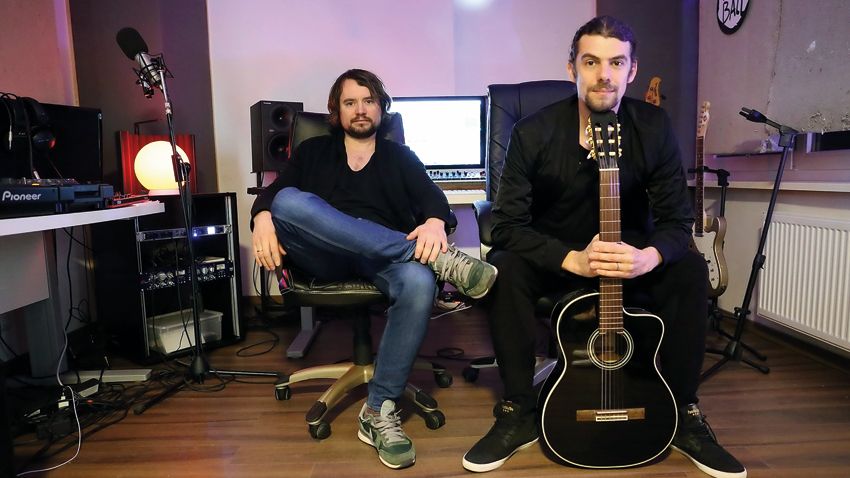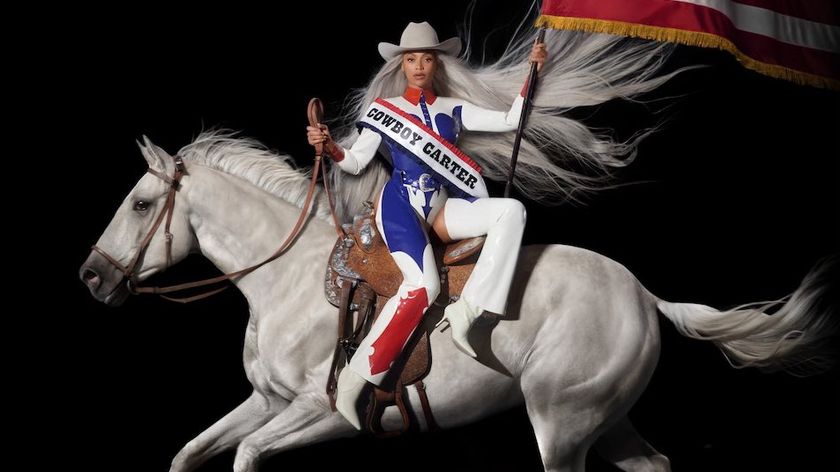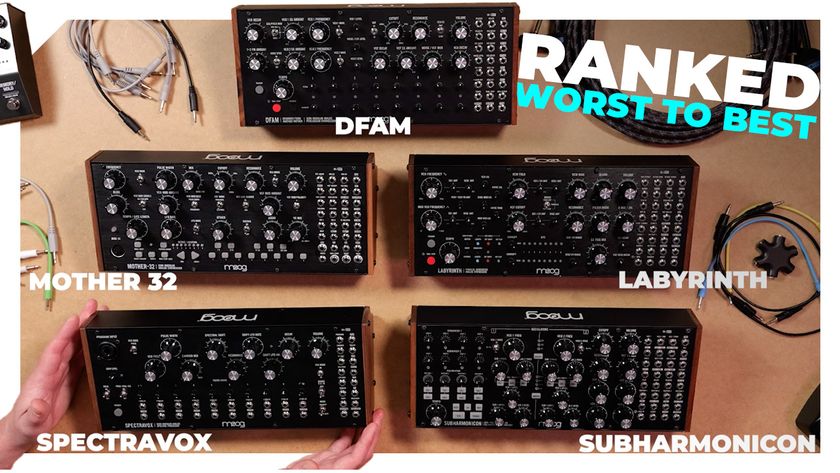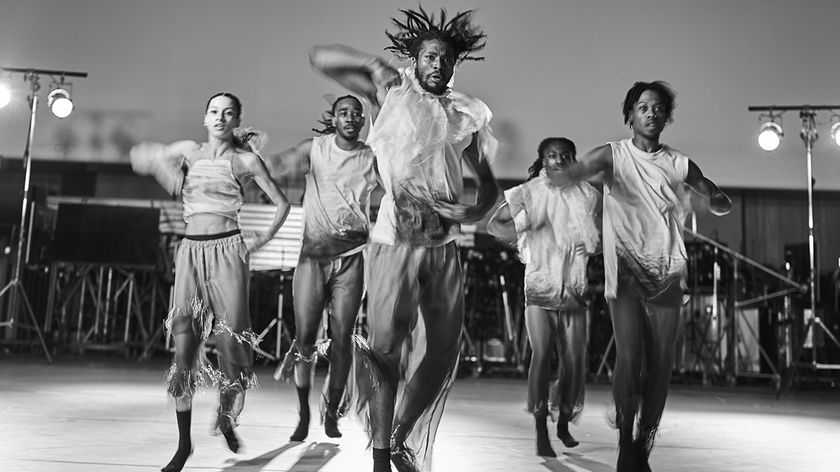Tube & Berger on the making of new album We Are All Stars
We meet the duo and find out more about their long-awaited second album

Coming from humble beginnings in a small industrial town in Germany, it would be fair to say that Arndt Rörig and Marko Vidovic didn’t exactly hit it off. Their first meeting on a school bus almost came to blows, until the duo discovered a shared interest in “beer, girls and music”. They joined a punk band, but later immersed themselves in the burgeoning '90s house/techno scene, forming the production duo Tube & Berger.
Success came almost immediately when their debut single Straight Ahead (2003) zoomed to the top of the Billboard Dance Radio Chart - with a little help from Chrissie Hynde on vocals. Rather than rinse and repeat, Rörig and Vidovic evolved their sound, swerving the fashion for minimalist house in favour of a more emotionally appealing approach based on acoustic sampling.
The success of Tube & Berger’s evolution saw them became staple Beatport hit makers. While mentoring artists on their own Kittball Records label, their careers were punctuated by chilled, acoustic masterpieces such as Imprint of Pleasure (2014). This year sees a further modification of the Tube & Berger sound with their new album, We Are All Stars, which sees the production duo returning to their indie rock roots, in conjunction with their always thoughtful deep house aesthetic.
You had a massive hit in the US with your very first single in 2003, Straight Ahead. Was it a shock that success came so quick?
Arndt Rörig: “Neither of us was prepared back in the day because we were both really young. We signed a bad deal and made every mistake you can make, but the success of that track was brilliant and we saw our video every day on MTV.”
Did that bring immediate expectation and pressure on you to repeat your success?
AR: “Yeah, absolutely. The thing is, we sort of started from scratch after that. We wanted to build our names as DJs in our area and weren’t able to come up with a follow-up single. But looking back, it doesn’t feel bad at all. It was a journey and our first hit definitely brought us into the scene and made us believe we could be musicians. We had worked in the studio long before that and always dreamed of success - then it suddenly appeared. I don’t think we realised what happened until about a year later.”
Get the MusicRadar Newsletter
Want all the hottest music and gear news, reviews, deals, features and more, direct to your inbox? Sign up here.
Your sound was very accomplished right from the start. You hinted that you already had a lot of studio experience…
AR: “That’s because we started as a punk band when we were kids, playing drums, guitars and bass, so the advantages we had when it came to making electronic music did not just come from the DJ world but being musicians before that.”
Your Kittball Records label is still going strong, but has it been difficult to adapt to the digital age?
AR: “Yeah, we’ve had our ups and downs, especially when the vinyl market crashed. We were close to ending Kittball at that point. But with the help of Juliet Sikora and P.A.C.O. - our two other members - we managed to bring the label back. It was actually Marc Romboy who helped us set up the label for the vinyl market. The initial idea was not just to release our own tracks, but to do all the A&R as well.”
Is the resurgence of vinyl a reality for you?
AR: “You hear from everywhere that vinyl is back and people are starting to collect records again. So do we, and I think it’s great that vinyl has not gone. Although everyone is playing MP3s on their computers, a lot of people are still listening to vinyl at home.”
Marko Vidovic: “We’d love to do more with the label, but because we're always touring, have families and produce our own stuff, that grabs all of our time. But we definitely do more A&R now for Kittball. It was always the plan to help other artists produce albums and singles, and that’s still on the agenda. The most successful A&R route is usually the more spontaneous one, like meeting someone at a festival and getting them to send music to us.”
It’s been five years between albums and a lot’s happened in between. When did you decide to sit down and start working on We Are All Stars?
MV: “I think it was about one year before we decided that we really wanted to make a second album. We’d had a lot of singles between our album releases because we just thought it made more sense to release singles for the DJ market. An album is not produced to be 12 DJ singles and we prefer to call We Are All Stars our ‘Adventures in Pop’. We just did what we wanted and didn’t really care if it fitted the house style or what people might expect from us. So the album’s a little bit different to what we would normally produce with the singles.”
Nobody wants albums anymore and sometimes singles are more important, but we thought we’d do the album and make it a journey. We’re actually thinking about releasing another one right away because we made a lot of songs that took a step closer to the club world.
20-30 years ago the album was king, but now singles and EPs make a much bigger impact…
AR: “Nobody wants albums anymore and sometimes singles are more important, but we thought we’d do the album and make it a journey. We’re actually thinking about releasing another one right away because we made a lot of songs that took a step closer to the club world. Maybe we will release an EP first or keep releasing singles after the album, but we definitely want to release more stuff.”
Did you have to lock yourself away and take a back seat from DJing to focus on this album?
MV: “Yeah, definitely. We took off December and January so we could find some time. It’s really hard to DJ on Fridays and Saturdays, come back Sunday, have some rest with the family and kids, and still have enough time to spend in the studio. Once we get into that studio vibe, it’s better to lock ourselves into it.”
How would you say the Tube & Berger sound has evolved? We understand you wanted to make the album more live-sounding…
AR: “Yeah, we want to become a band again and not just DJs playing records for other people. We are working on our live act more and more and hope to use our vocalist Richard Judge for the live shows when we go out on tour. We love DJing and the whole club culture, so we definitely want to continue doing that, but we also want to set up this live show. In fact, Marko is working on some crazy visuals. We have seen artists like Daft Punk and The Chemical Brothers, so there’s a lot of work for us to do.”
MV: “There will be a We Are All Stars album tour, but it will also include DJing. Our first live gig will be at a big festival in Munich in the middle of June. That will be the start for the new live show.”
The album sounds as though you're open to exploring more themes and ideas, encompassing a lot of different styles/genres?
MV: “I think it was more about being open-minded and not just thinking about the DJ music we're playing. It’s difficult to explain, but in the first few months the music we were making was starting to sound more like a DJ album. Then we just dived into the whole songwriting process and found that certain tracks started to sound downtempo and were no longer suitable for a club; or we’d add a guitar and find that the song would evolve in a completely different way.”

You mentioned Richard Judge, who appears on several tracks. What did you like about his vocal style that led you to decide to give him such a prominent role?
AR: “We have become friends in recent years. The first song we did together was Disarray in 2015, after he sent some rough demo ideas to us. I think he saw us at Tomorrowland a few years back and wanted to work with us.”
MV: “It’s always great to work with Richard because he only needs two minutes to come up with a song idea. We play a track without lyrics and he takes one hour to write them, and within two hours we have a complete song. He’s born for this, but he’s also very motivated, and that motivates us too. He came over for sessions and we had a few beers and jammed.”
Tell us about the track Quiet Time with White Lies - it’s very electropop sounding and the vocal is different to what people may expect…
AR: “We made a remix for White Lies at one point and were also reaching out to several artists and asking if they wanted to join us on this album. White Lies told us they had this track, a very 80s rock demo. As you said, we instantly knew that this would be different.”
MV: “We both love the 80s and were born in the 80s, so we did not want to change the track completely, just make it a bit faster and clubbier. For the drumming, we chose 80s sounds, particularly for the snare. At the session, we used a friend who is a great piano player and he did an intro, which sounds awesome. We produced the track and they loved it - it will be our next single now.”
Tracks like Lucky Shot are reminiscent of Daft Punk - would you agree?
AR: “There is definitely a bit of Daft Punk attitude. We changed from punk music or rock music to electronic music when Daft Punk’s Homework came out. Out of all the artists in dance music, they are the ones who have probably influenced us the most.”
The track features sounds that other people might have been afraid to go near for fear of everything sounding a bit cheesy. Is it important for would-be producers to be bold in their choice of sounds?
AR: “I think that’s just how the album evolved. It takes a certain kind of bravery to use these cheesy sounds, as you describe them, but we tried to do them in a punk way. It’s interesting that you said people tend not to use these sounds. It was hard to control it, it was just how the song came out and you can’t always explain why a certain sound fits a song.”
MV: “What we really don’t like is the current EDM sounds, which are really nerdy. We couldn’t ever put them into one of our tracks. I would like to know which sounds you really liked and think are cheesy. Of course, we discussed that, because it’s not very Tube & Berger, but we wanted that 80s pop aesthetic. Of course, there will also be a club edit for people who are into that.”
What vocoder did you use on that track?
MV: “It was from the microKorg, but the machine got burned now. There was smoke coming out of it and now it’s dead. It was heavily used and we toured with it a lot, so I guess that’s why that happened; but it’s not that expensive so we’ll get a new one soon.”
Do you feel the key is not to get locked into what the instruments can do, but to put all your energy into creative ideas and have a clear idea of how you want a track to sound before you start?
AR: “I think that neither of us is a fan of super abstract arrangements, although that’s something that could come into our future productions. For me, it feels a bit like there’s not enough space on one album to put out all the ideas that we have. I’d like to have 20 tracks, but our manager or label would only tell us that nobody will listen to 20 tracks.”
The track International Corporate Motherfuckers sounds like you are railing against capitalism…
AR: “That’s a protest song. It’s basically about all the shit going on out there, when you see all these weird politicians pleading for more military, borders and cameras.”
MV: “There are some countries that we don’t like to fly to right now because of political motherfuckers. Everything is led by these big companies. You’re not free when you’re born on the earth today because they have a plan for you already.”
AR: “Promoting it is not easy on social media and stuff because it’s got the name ‘motherfuckers’ in it. We actually just released a video for it today. We built in some footage from the news and the revolutions in France, and 9/11 plays a role. You have to watch it, I spent three weeks working on it and it says a lot.”
Another track that differentiates itself is Fetzen, where the deep analogue-sounding synths are reminiscent of Vangelis or Jean-Michel Jarre?
MV: “All I remember is the nights we started working on it, and nothing happened until about 2am in the morning just before we were about to
go home. We suddenly found one synthesizer sound we loved – I think it was from the Serum VST plugin. It had this fresh sound, but then we added about ten others. I think it’s an EQ thing. We use different little tricks and EQ a lot of the sounds in different layers. Sometimes we’ll put a guitar amplifier on a sound, but we don’t do that deliberately to make it sound analogue.”
Promoting it is not easy on social media and stuff because it’s got the name ‘motherfuckers’ in it. We actually just released a video for it today. We built in some footage from the news and the revolutions in France, and 9/11 plays a role. You have to watch it, I spent three weeks working on it and it says a lot.
What software sequencer are you using?
AR: “Cubase, which we’ve been using right from the early days. There was a time when we just used PCs and were working with Logic and Cubase simultaneously, but now Cubase is our main software DAW at home because Microsoft stopped producing Logic for PCs. These days, people laugh at us because they say Ableton is so much quicker and easier to use. It is easier and faster to get ideas down on Ableton, and we do use Ableton Rewire as a VST plugin in Cubase sometimes. We also use Ableton Live on the road and for all our DJ mixes.”
MV: “The thing is, we’re so used to Cubase from the early days and feel as though we can definitely go deeper into the production using Cubase rather than with Ableton.”

Tell us about some of your go-to plugins?
AR: “In terms of VST plugins, we like to use some pretty cool Sylenth pads and presets. As mentioned, we also use Serum and Omnisphere, but there’s a new one that’s really great called Avenger, which is a VST synth by Vengeance–Sound. We only bought it a week ago, but the sounds are really nice and you don’t have to use the presets in the way they were designed. There is one called Future House, but you don’t have to use it in a house track. The sound quality and diversity of sounds are really good - I really hope they make more packs for it.”
MV: “When you don’t upgrade your studio for a year and somebody tells you about all these new synths out there, we always take another big new step. But it’s not just about using presets, we like to morph the sounds a little bit and always layer two or three sounds to create one great big sound.”
Do you have any hardware synths in the studio?
MV: “Yes, we used the Sequential Prophet-6 a lot on the album. It’s an analogue synthesiser, but there is a retro thing about it - you can handle it like a digital synthesiser and the sounds are really 70s sounding. Maybe it just reminds us of something from our childhood, but it’s definitely our favourite piece of hardware. We’ve also got an Access Virus, but it’s been standing there for a few years now and we never use it.”
AR: “It’s a shame that the Virus just stands there, but it was the Prophet-6 that really carried us through the album. There was a time when we started collecting quite a bit of hardware and then we sold everything and moved to using VSTs. But we definitely want to get more analogue stuff again, simply because they’re more fun to play around with and have a better sound quality. Even now, it’s easier to find a good-sounding preset on a hardware synth than with a VST plugin. We’d also like to look into modular, but haven’t found the time yet.”
Is using hardware synths more helpful when it comes to post-production?
MV: “Yes, I think so. With the VSTs we have to work on the sounds a lot, but with the Prophet we only used a little EQ and maybe a little bit of reverb, because it always has a tight sound. But most of the effects processing we do is in the box. I really love Slate Digital plugins because they’re pretty good for that sort of thing. They’re great for so-called ‘harmonic mixing’, and make it very easy to find the right frequencies that you want. I also find that FabFilter makes EQing very easy, because you can solo the frequencies.”
AR: “I’m a big fan of Soundtoys and really love the Crystallizer. It’s got some crazy atmospheres built into the sounds, and it’s really good to layer sounds and build up these big effects.”
Can you share your expertise and give MusicRadar readers some production tips?
AR: “We play around with the sound panorama a lot. I don’t think you should be shy when it comes to panning sounds too far on the left or right. If you use plugins like the Crystallizer, they can add stereo effects that give your sounds more of a stereo experience. I would add that we have moved away from using too much compression on our tracks. We have this debate between us, because someone read somewhere that you don’t need drum compression if you do the right EQ and voluming, so we eased off on the compression when we recorded the album and it’s much better for it.”
MV: “We stopped doing sidechain compression. We work with the LFO Tool and basically paint the sidechain by drawing it on the screen. That way, you have the sidechain effect under complete control. When you can add subtle compression here and there, the whole groove changes and it gives you a lot more precision. We like to use the envelope shaper on Cubase when working on loops and drums to play around with the release and shorten the length of the drumming to make it tighter.”
You once said you’ve performed everywhere from a $200m yacht to a warehouse in Dublin in front of 50 people. Which do you prefer?
AR: “It’s the same as the question, ‘Do you prefer intimate small clubs or big stages?’ It’s the mix of everything - the hashtag DJ life thing. It’s difficult to say, but playing on that crazy expensive yacht was definitely something to remember and talk about. The problem is, you’re always chasing the next big thing, but of course not every gig can be great. Every weekend is a new gamble - will we get this feeling or not?”
MV: “Brazil is a great place to play, people go crazy a lot more than in Europe. They have all these daytime parties and show their bodies. But Europe is wilder than the US, because in many states their venues have to close at 2am, whereas in Europe it’s all just about to start. We’ve never played in Japan - that’s somewhere we’d really love to go.”
We Are All Stars is out now via BMG & Kittball Records.


Future Music is the number one magazine for today's producers. Packed with technique and technology we'll help you make great new music. All-access artist interviews, in-depth gear reviews, essential production tutorials and much more. Every marvellous monthly edition features reliable reviews of the latest and greatest hardware and software technology and techniques, unparalleled advice, in-depth interviews, sensational free samples and so much more to improve the experience and outcome of your music-making.

"Reggae is more freeform than the blues. But more important, reggae is for everyone": Bob Marley and the Wailers' Catch a Fire, track-by-track

“Part of a beautiful American tradition”: A music theory expert explains the country roots of Beyoncé’s Texas Hold ‘Em, and why it also owes a debt to the blues











